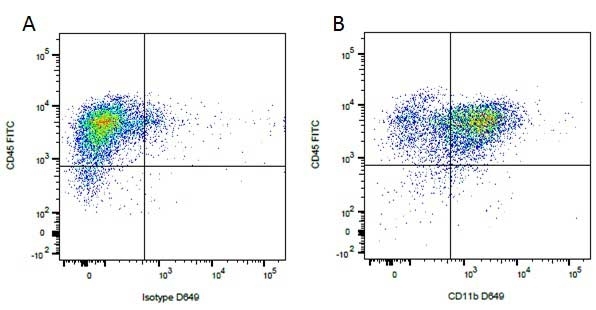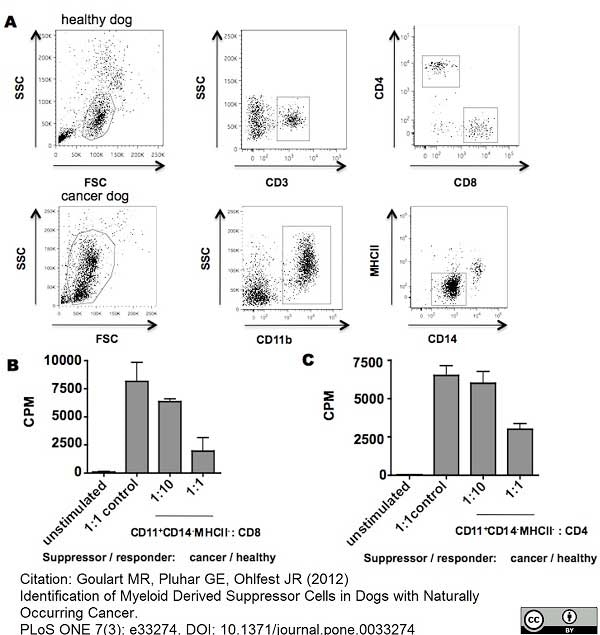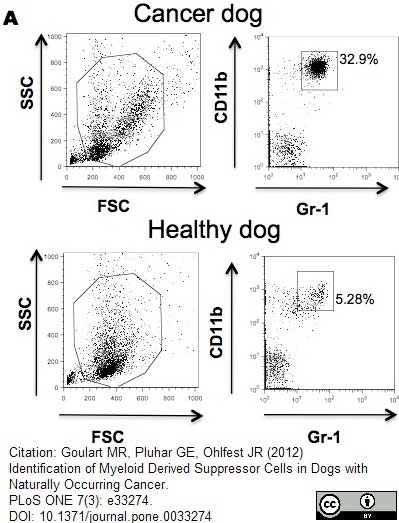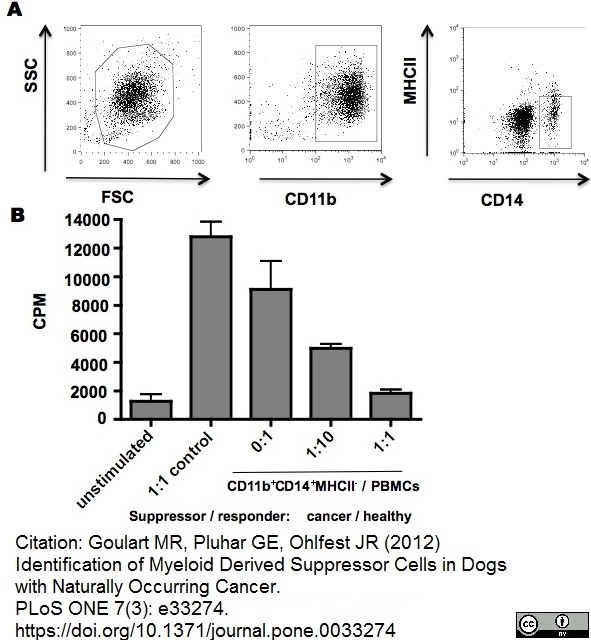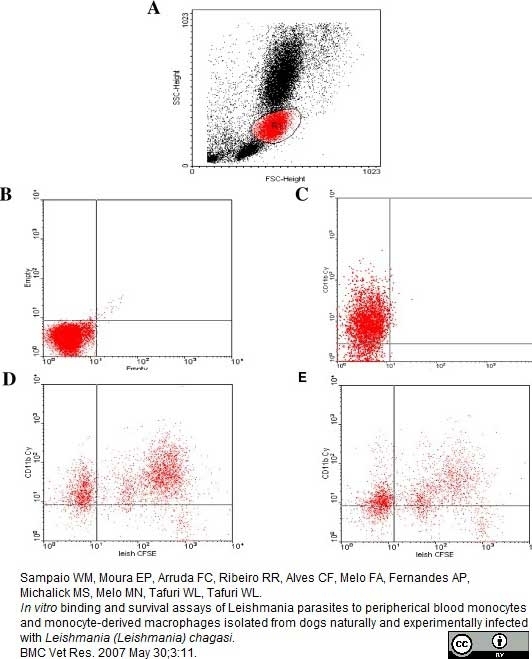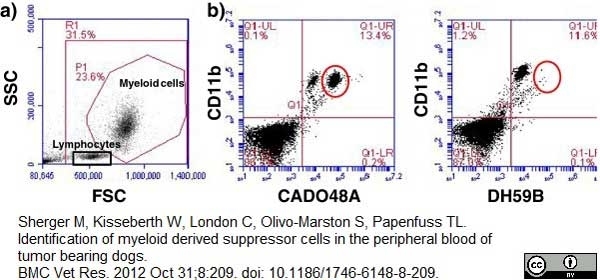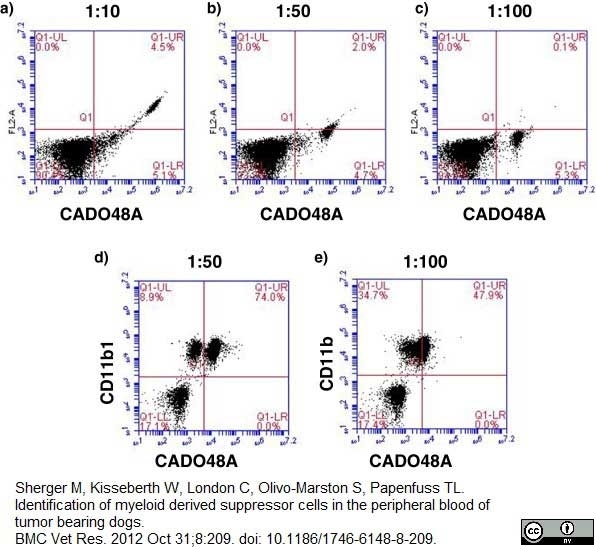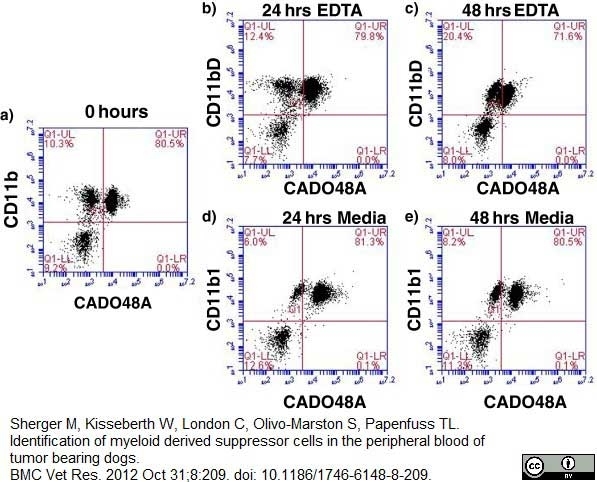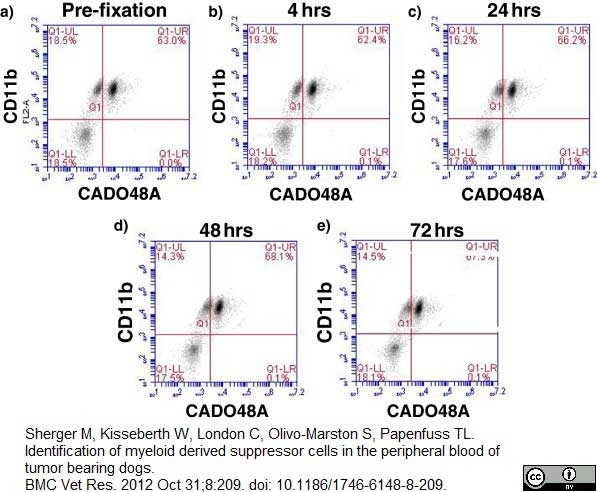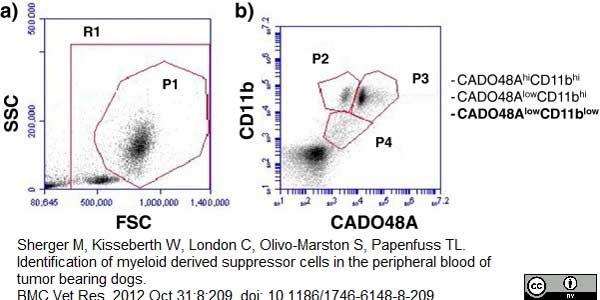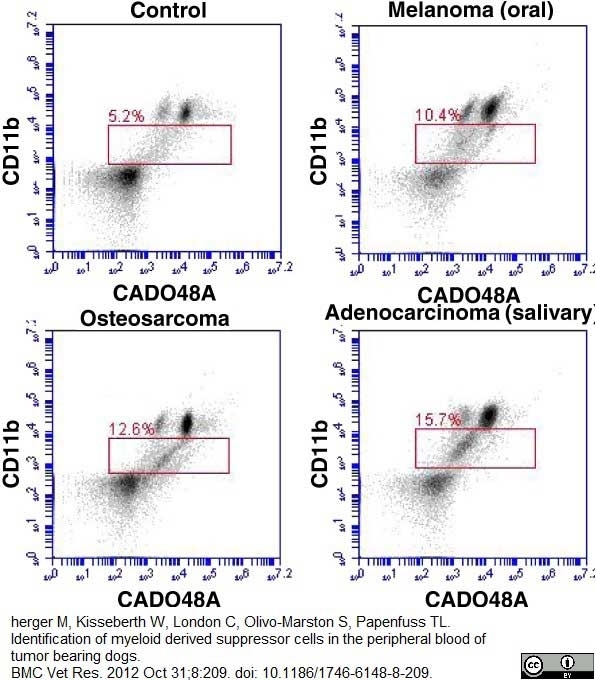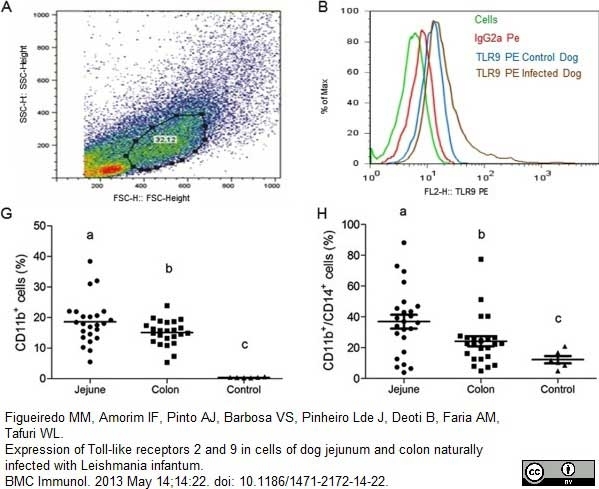CD11b antibody | CA16.3E10












Mouse anti Dog CD11b
- Product Type
- Monoclonal Antibody
- Clone
- CA16.3E10
- Isotype
- IgG1
- Specificity
- CD11b
| Mouse anti Dog CD11b antibody, clone CA16.3E10 is a monoclonal antibody recognizing the canine CD11b cell surface antigen, a member of the alpha integrin family. CD11b forms one of the possible alpha chains of the canine leukocyte adhesion complexes (LeuCAMs), these contain a common 95 kDa β chain (CD18) non-covalently bound to either a 150 kDa (CD11c), 165 kDa (CD11b) or 180 kDa (CD11a) α chain (Moore et al. 1990. The CD11/CD18 complex is also known as the CR3 receptor. Canine CD11b is expressed by granulocytes, monocytes, NK cells and some macrophages. Mouse anti Dog CD11b antibody, clone CA16.3E10 has been used to evaluate the effect of anesthetic administration of CD11b expression on canine neutrophils (Maeda et al. 2010) demonstrating attenuation of CD11b expression at high concentrations administered lidocaine hydrochloride and reduced adhesion of neutrophils to endothelium. |
- Target Species
- Dog
- Species Cross-Reactivity
-
Target Species Cross Reactivity Goat Cat Mustelid Pig Bovine Mink Beluga whale - N.B. Antibody reactivity and working conditions may vary between species.
- Product Form
- Tissue culture supernatant - liquid
- Preservative Stabilisers
- <0.1% sodium azide (NaN3)
- Immunogen
- Affinity purified beta-2 integrins from splenic lysate
- Regulatory
- For research purposes only
- Guarantee
- 12 months from date of despatch
Avoid repeated freezing and thawing as this may denature the antibody. Storage in frost-free freezers is not recommended.
| Application Name | Verified | Min Dilution | Max Dilution |
|---|---|---|---|
| Flow Cytometry | Neat | ||
| Immunohistology - Frozen 1 | |||
| Immunohistology - Paraffin | |||
| Immunoprecipitation |
- 1The epitope recognised by this antibody is reported to be sensitive to formaldehyde fixation and tissue processing. Bio-Rad recommends the use of acetone fixation for frozen sections.
- Flow Cytometry
- Use 10μl of the suggested working dilution to label 106 cells or 100μl whole blood
| Description | Product Code | Applications | Pack Size | List Price | Your Price | Quantity | |
|---|---|---|---|---|---|---|---|
| Mouse IgG1 Negative Control | MCA928 | F | 100 Tests |
|
Log in | ||
| List Price | Your Price | ||||||
|
|
Log in | ||||||
| Description | Mouse IgG1 Negative Control | ||||||
References for CD11b antibody
-
Danilenko, D.M. et al. (1992) Canine leukocyte cell adhesion molecules (LeuCAMs): characterization of the CD11/CD18 family.
Tissue Antigens 40: 13-21. -
Brodersen, R. et al. (1998) Analysis of the immunological cross reactivities of 213 well characterized monoclonal antibodies with specificities against various leucocyte surface antigens of human and 11 animal species.
Vet Immunol Immunopathol. 64 (1): 1-13. -
Kruger, E.F. et al. (2003) Bovine monocytes induce immunoglobulin production in peripheral blood B lymphocytes.
Dev Comp Immunol. 27 (10): 889-97. -
Kamstock, D. et al. (2006) Liposome-DNA complexes infused intravenously inhibit tumor angiogenesis and elicit antitumor activity in dogs with soft tissue sarcoma.
Cancer Gene Ther. 13: 306-17. -
Sampaio, W.M. (2007) In vitro binding and survival assays of Leishmania parasites to peripherical blood monocytes and monocyte-derived macrophages isolated from dogs naturally and experimentally infected with Leishmania chagasi.
BMC Vet Res. 3:11. -
Yuasa, K. et al. (2007) Injection of a recombinant AAV serotype 2 into canine skeletal muscles evokes strong immune responses against transgene products.
Gene Ther. 14: 1249-60. -
Gregorevic, P. et al. (2009) Evaluation of vascular delivery methodologies to enhance rAAV6-mediated gene transfer to canine striated musculature.
Mol Ther. 17: 1427-33. -
Maiolini, A. et al. (2012) Toll-like receptors 4 and 9 are responsible for the maintenance of the inflammatory reaction in canine steroid-responsive meningitis-arteritis, a large animal model for neutrophilic meningitis.
J Neuroinflammation. 9: 226.
View The Latest Product References
-
Sherger, M. et al. (2012) Identification of myeloid derived suppressor cells in the peripheral blood of tumor bearing dogs.
BMC Vet Res. 8: 209. -
Wasserman, J. et al. (2012) Suppression of canine myeloid cells by soluble factors from cultured canine tumor cells.
Vet Immunol Immunopathol. 145 (1-2): 420-30. -
Paltrinieri, S. et al. (2012) Flow cytometric detection of alpha-1-acid glycoprotein on feline circulating leucocytes.
Aust Vet J. 90 (8): 291-6. -
Yu, D.H. et al. (2012) Pathophysiologic and immunologic changes in a canine endotoxemia over a period of 24 hours.
J Vet Med Sci. 74 (5): 537-44. -
Mastrorilli, C. et al. (2012) Multifocal cutaneous histiocytic sarcoma in a young dog and review of histiocytic cell immunophenotyping.
Vet Clin Pathol. 41 (3): 412-8. -
Vermeulen, B.L. et al. (2013) Suppression of NK cells and regulatory T lymphocytes in cats naturally infected with feline infectious peritonitis virus.
Vet Microbiol. 164 (1-2): 46-59. -
Figueiredo, M.M. et al. (2013) Expression of Toll-like Receptors 2 and 9 in cells of dog jejunum and colon naturally infected with Leishmania infantum.
BMC Immunol. 14: 22. -
Michael, H.T. et al. (2013) Isolation and characterization of canine natural killer cells.
Vet Immunol Immunopathol. 155 (3): 211-7. -
Olyslaegers, D.A. et al. (2013) Altered expression of adhesion molecules on peripheral blood leukocytes in feline infectious peritonitis.
Vet Microbiol. 166 (3-4): 438-49. -
Guth, A.M. et al. (2013) Liposomal clodronate treatment for tumour macrophage depletion in dogs with soft-tissue sarcoma.
Vet Comp Oncol. 11 (4): 296-305. -
Wijewardana, V. et al. (2013) Production of canine soluble CD40 ligand to induce maturation of monocyte derived dendritic cells for cancer immunotherapy.
Vet Immunol Immunopathol. 156 (1-2): 121-7. -
Thompson, L.A. & Romano, T.A. (2015) Beluga (Delphinapterus leucas) granulocytes and monocytes display variable responses to in vitro. pressure exposures.
Front Physiol. 6: 128. -
Gow, A.G. et al. (2016) Low-Density Lipoprotein Uptake Demonstrates a Hepatocyte Phenotype in the Dog, but Is Nonspecific.
Stem Cells Dev. 25 (1): 90-100. -
Kuraoka, M. et al. (2016) Serum Osteopontin as a Novel Biomarker for Muscle Regeneration in Duchenne Muscular Dystrophy.
Am J Pathol. 186 (5): 1302-12. -
Wang, L. et al. (2019) Electroacupuncture-induced cannabinoid receptor expression in repair of abducens nerve.
Int J Neurosci. 129 (9): 923-9. -
Hutchison, S. et al. (2019) Characterization of myeloid-derived suppressor cells and cytokines GM-CSF, IL-10 and MCP-1 in dogs with malignant melanoma receiving a GD3-based immunotherapy.
Vet Immunol Immunopathol. 216: 109912. -
Beirão, B.C.B. et al. (2020) A blocking antibody against canine CSF-1R maturated by limited CDR mutagenesis
Antibody Ther: 3.3: 193–204. -
Thompson, L.A. & Romano, T.A. (2019) Effects of health status on pressure-induced changes in phocid immune function and implications for dive ability.
J Comp Physiol B. 189 (5): 637-57. -
Jarosz, Ł. et al. (2022) The Effect of Feed Supplementation with EM Bokashi® Multimicrobial Probiotic Preparation on Selected Parameters of Sow Colostrum and Milk as Indicators of the Specific and Nonspecific Immune Response.
Probiotics Antimicrob Proteins. 14 (6): 1029-1041. -
Knebel, A. et al. (2021) Measurement of canine Th17 cells by flow cytometry.
Vet Immunol Immunopathol. 243: 110366. -
Riccardo, F. et al. (2022) Antigen mimicry as an effective strategy to induce CSPG4-targeted immunity in dogs with oral melanoma: a veterinary trial.
J Immunother Cancer. 10(5):e004007. -
Troupel, T. et al. (2022) Generalised idiopathic polymyositis mimicking masticatory myositis in a dog
Veterinary Record Case Reports. 2022;10:e452 -
Wesolowski, M. et al. (2023) Long-term changes of Th17 and regulatory T cells in peripheral blood of dogs with spinal cord injury after intervertebral disc herniation.
BMC Vet Res. 19 (1): 90. -
Bencze, M. et al. (2023) Receptor interacting protein kinase-3 mediates both myopathy and cardiomyopathy in preclinical animal models of Duchenne muscular dystrophy.
J Cachexia Sarcopenia Muscle. Nov 01 [Epub ahead of print]. -
Mason, N.J. et al. (2021) Development of a fully canine anti-canine CTLA4 monoclonal antibody for comparative translational research in dogs with spontaneous tumors.
MAbs. 13 (1): 2004638.
- Synonyms
- Integrin Alpha M Chain
- MAC-1
- RRID
- AB_322922
MCA1777S
If you cannot find the batch/lot you are looking for please contact our technical support team for assistance.
Please Note: All Products are "FOR RESEARCH PURPOSES ONLY"
View all Anti-Dog ProductsAlways be the first to know.
When we launch new products and resources to help you achieve more in the lab.
Yes, sign me up